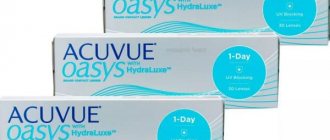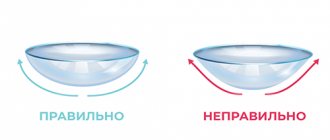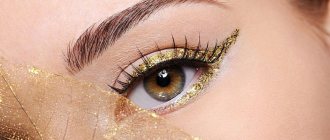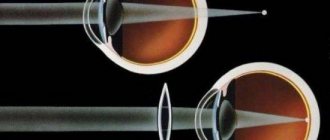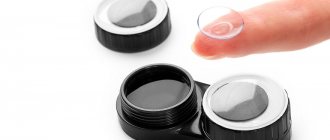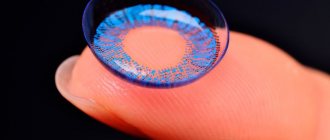What you need to know about lenses
Designed for one month of use, the lenses are soft contact lenses that can be worn for up to thirty days. It is recommended to remove them at night, having first cleared them of accumulated deposits and small particles of debris. The next morning, a cleaned and disinfected pair of lenses is put on.
The big advantage of monthly lenses is that they save money due to their long use time. The package can contain from three to six blisters. If the package contains six blisters, then the lenses will last for three whole months.
Air Optix Night {amp}amp; Day Aqua
Experts recommend wearing monthly soft contact lenses in the following cases:
- If the sebaceous glands secrete a large amount of secretion, which contributes to the accumulation of sediment.
- People who have suffered various complications and inflammations of the eyes.
- If the lenses are easily lost and torn.
- People whose profession involves prolonged exposure to dusty conditions, interaction with chemical reagents and other unfavorable factors.
One-month contact lenses have many advantages, which is why they are so popular among those who use such optics.
Main advantages:
- Such lenses have the most comfortable and optimal wearing period. Within thirty days, protein deposits do not have time to accumulate on their surface. Therefore, the lenses are comfortable and absolutely safe, but subject to the rules for caring for contact lenses, this article will tell you more about this.
- Monthly lenses can be purchased at an affordable price. Usually you have to pay about one and a half thousand rubles for a package with three pairs of lenses.
- The material used to make these lenses is completely harmless. It does not cause discomfort and does not adversely affect eye tissue. The material has a sufficient degree of moisture and oxygen permeability, so that the eyes do not experience dryness and constantly “breathe”.
- The wide range of corrections in which monthly contact lenses are available allows you to correct vision for both nearsightedness and farsightedness at the same time, as well as astigmatism. It usually varies from plus six to minus twelve diopters. (Optical correction is the most common treatment for astigmatism.)
- There are monthly colored and tinted lenses that can be used both to correct vision pathology and to create an image.
Bausch{amp}amp; Lomb
Contact lenses with a wear period of three months are also called quarterly or scheduled replacement lenses. They are perfect for vision correction for myopia and farsightedness. Experts call this type of lenses transitional between contact optics of planned replacement and traditional ones.
Hydrogel is most often used as a manufacturing material. It may differ in its characteristics, for example in moisture content. Another material for making lenses for three months is silicone hydrogel (silicone hydrogel lenses).
Air Optix Individual – three-month contact lenses
Quarterly contact lenses have a large number of advantages:
- They provide high quality vision throughout the entire period of use.
- The lenses are made of fairly durable material that protects them from damage.
- They have a good degree of hydration, so the eyes do not feel dry and tired.
- Many lens models have a special filter that protects the eyes from the harmful effects of ultraviolet radiation.
- Such lenses are presented not only in classic transparent models, but also in colored and tinted ones, which can be used both for vision correction and for a cosmetic effect.
Review of lenses you can sleep in
Quite a lot of models of this type are produced today. The most famous, which are in demand and approved by ophthalmologists, are:
Air Optix Night & Day Aqua
These are lenses from Alcon (CIBA Vision). They can be left on for 30 days. These ophthalmic products can be used continuously without removal for 30 days. At the same time, you can wear them in daytime, flexible or extended mode. These lenses have undergone clinical trials involving 114 people. Studies have shown that wearing the presented contact optics continuously for a month does not cause discomfort or complications.
Air Optix Night & Day Aqua is made from the silicone hydrogel material Lotrafilcon A. It has the following features:
- High oxygen permeability - 175 Dk/t. Even during sleep, oxygen will flow to the cornea.
- Hydrophilicity and good wettability. The lenses are plasma treated. They have a perfectly smooth surface.
- Resistant to protein and lipid deposits.
Air Optix Night & Day Aqua are designed to correct myopia and farsightedness. The inner and outer surfaces of the lenses are aspherical. They will not be bothered by glare and halos. The image remains with maximum contrast even in twilight.
ACUVUE Oasys with Hydraclear Plus
These lenses are developed by the famous company Johnson & Johnson. Contact optics of the ACUVUE Oasys series are considered one of the most comfortable and safe. The presented model is designed for two weeks of use. But it can be worn in a prolonged mode, that is, 7 days without removing it. When worn this way, the service life of the lenses is halved. You put them on after opening the blister, and take them off and throw them away after 7 days.
ACUVUE Oasys with Hydraclear Plus are made from Senofilcon A silicone hydrogel. It transmits up to 147 oxygen units and is 38% hydrated. The patented Hydraclear Plus technology is used in the manufacture of these contact optics. With its help you can achieve:
- high hydrophilic properties;
- super smooth surface;
- resistance to various types of deposits.
These lenses can be worn by patients with sicca keratitis and eye sensitivity. However, in such cases, the prolonged regimen is contraindicated. Before purchasing, be sure to visit an ophthalmologist.
Two-week ACUVUE Oasys are suitable for nearsighted and farsighted people, even with high degrees of refractive error.
PureVision 2 HD for Astigmatism
These are lenses with a toric design. They are designed to correct astigmatism. At the same time, they compensate for one of the associated pathologies - myopia or hypermetropia. This model is produced by Bausch + Lomb. The lenses are equipped with an improved Auto Align Design stabilization system. They quickly stabilize on the eyeball and do not move when tilting the head or changing body position. You can play sports in these ophthalmic products. They guarantee high-quality images even during intense physical activity.
PureVision 2 HD for Astigmatism is one of the few toric contact lenses that can be worn in extended wear mode. They are made from silicone hydrogel using ComfortMoist technology, which gives them a number of positive properties:
- good oxygen permeability (91 Dk/t), which allows the eyes to “breathe”;
- resistance to dehydration;
- long-term wearing without feeling dry or irritated.
HD stands for High Definition. Lenses in this series have excellent optical performance. They cope even with severe forms of refractive errors.
Biofinity multifocal
Just a few years ago, many people with presbyopia had to keep two pairs of glasses with them - for distance and for near. Today there are multifocal lenses that are equipped with several optical centers to correct vision at different distances. Moreover, it is now possible to purchase contact optics with a multifocal design, which can be worn extended - 6 nights/7 days.
Biofinity multifocal is produced by CooperVision, which produces them from the silicone hydrogel polymer Comfilcon A. The main features of this model:
- air permeability up to 142 DCL;
- moisture content - 48%;
- ultra-thin design - 0.08 mm;
- Aspherical front surface for improved vision quality.
Biofinity multifocal is created using exclusive Aquaform technology. The lenses are endowed with natural hydrophilic properties. They retain moisture, preventing dehydration. These products are manufactured using another technology - “Progressive Balance”. There are several optical zones. They “adjust” to a person when he looks near or into the distance, and provide clear vision at any distance.
MagazinLinz.ru team
Specifics of wearing mode
As the name suggests, monthly lenses can be worn for thirty days, that is, one month.
A damaged lens must be replaced, otherwise microscopic cracks and scratches can cause a lot of discomfort and cause traumatic effects on the ocular surface. Every day before going to bed, it is recommended to remove your lenses, clean and disinfect them with a special solution for contact lenses, and leave them in a storage container for at least a few hours.
The mode of wearing contact lenses for a month has its own specific characteristics. You can use the lenses in daytime mode. In this case, the lenses must be removed at night. And in prolonged (read what this means and about long-term wear lenses here) or continuous mode - you can even sleep in the lenses.
As you understand, not everyone can afford daily lenses due to their high cost. It is much cheaper to buy durable products. There are two types of monthly lenses:
- daytime;
- extended wear lenses that you can sleep in.
The second type of lenses is usually made of silicone hydrogel material, which has excellent oxygen permeability and does not have a low elasticity coefficient. Long-term wear lenses are comfortable to sleep in. Moreover, with continuous use, the patient forgets that there are foreign objects in the eyes.
Read more about soft lenses here.
As mentioned earlier, three-month lenses are made of dense but durable material. Despite its resistance to damage, it does not have very high gas permeability, unlike the material of daily contact lenses. Therefore, quarterly contact lenses can only be worn during the day and for no more than eight hours at a time.
Square contact lenses
You should not leave quarterly lenses in overnight and sleep in them during the day, as hypoxia may develop or a lot of deposits will accumulate on their surface.
Lenses you can sleep in
Is it possible to sleep in contact lenses? What happens if you fall asleep without taking off your contact lenses? These are some of the most popular questions related to contact correction products. You can sleep in lenses. However, not in all of them. It is necessary to choose models with the following wearing modes:
- Flexible: ophthalmic products can be left on for two days.
- Extended: lenses can be left on the eyes for 7 days/6 nights.
- Continuous: you can wear contact lenses for 30 days without removing them.
Lenses in which you can sleep must allow oxygen to pass through well and have hydrophilic properties. Such ophthalmic products do not cause discomfort. After waking up, your eyes should not be dry or irritated.
Such contact correction products may be needed when moving, travelers, truck drivers and anyone who does not always have the opportunity to treat lenses with a solution after removal. Contact optics can be worn in flexible and extended mode only with the approval of a doctor. Such products are contraindicated if:
- increased sensitivity of the cornea;
- dry eye syndrome;
- violation of the composition of the tear fluid.
Tips for choosing lenses
The selection of contact lenses begins with collecting information about the patient (age, profession, diseases, etc.). A near and far vision test is then done. To test far vision, special tables or a sign projector are used. And for the neighbor - a table with text. In addition to these tests, others can be used. After this, objective refraction is determined using an autorefractometer. And with the help of trial lenses - subjective refraction.
Next, the parameters of the cornea are measured using an ophthalmometer or autorefractometer, and eye biomicroscopy using a slit lamp. If during the examination the doctor finds any contraindications to the use of lenses, then appropriate therapy is prescribed, after which the selection of lenses can be continued. If there are no contraindications, then the ophthalmologist selects the type of lenses, wearing regimen, and replacement period.
After this, the optical power, radius of curvature and lens diameter are calculated. And special disposable diagnostic lenses are tried on.
Clear Lab is one of the most sought after manufacturers
A comprehensive selection examination should include the following steps:
- Definition of the “leading” eye;
- Determination of distant visual acuity using tables or a sign projector;
- Determination of near visual acuity using a tex tablet;
- Determination of refraction by an objective method of autorefractometry;
- Determination of refraction by a subjective method using diagnostic lenses with different parameters;
- Study of binocular balance of selected lenses;
- Study of the accommodative ability of the eyes;
- Carrying out biomicroscopy using a slit lamp;
- Determination of the radius of curvature, diameter of the cornea using keratometry;
- Selection of contact lenses taking into account the collected medical history;
- Trying on trial diagnostic lenses to assess the quality of vision and their fit;
- Assessment of adaptation to lenses after keeping them on the eyes for twenty to thirty minutes;
- Training in proper handling and care of lenses;
- Issue a prescription, set a date for a follow-up examination.
Read about how long you can wear daily lenses by following the link.
Tips for caring for lenses
Lenses for three months, just like other types of contact lenses, are subject to mandatory care. It is quite simple, but all procedures must be performed daily.
- Manipulate lenses only with clean hands. All other devices (tweezers, container) must also be perfectly clean.
- You cannot wear lenses longer than the period stated by the manufacturer.
- Before putting on your lenses, you should inspect them for damage or remaining deposits. If the lenses are torn, they must be replaced.
- During illnesses with viral infections, you should stop wearing lenses so as not to transfer the infection to your eyes.
- All care, cleaning and disinfection products must be compatible with the lenses.
- You cannot wear other people's lenses and give yours to other people. This is fraught with conjunctivitis and other infections.
- If you experience discomfort, stop wearing lenses and consult a doctor.
Read about the mode of wearing day lenses in the material.
Daily lens care should include cleaning the surface of the lenses from deposits, rinsing and disinfecting.
Computer perimetry of the eye is described here.
Useful tips:
- Lenses should be cleaned immediately after removal.
- Under no circumstances should the universal disinfection solution be replaced with saline solution.
- If the lens is damaged, it must be replaced.
- Lenses should only be removed and put on with clean hands.
- The solution cannot be reused.
- The lenses must be completely immersed in the solution.
- The lid of the container must be tightly screwed on to prevent the lenses from drying out.
Why can't you sleep in daily wear lenses?
The cornea receives oxygen only from the air. When you put on lenses, the oxygen supply decreases, and when you close your eyes, it decreases even more. Without oxygen, the cornea swells and increases the risk of infection and inflammation, so the more you sleep in daytime lenses, the more damage you will cause to your eye health.
If you do fall asleep wearing lenses that are not intended for this purpose, remove them as soon as you wake up and give your eyes a day to rest. If irritation, redness, or dryness occurs, use special drops. If you have pain, sensitivity to light, blurred vision, or severe redness, consult a healthcare professional.
conclusions
Monthly lenses are very comfortable. They have a large number of advantages that make them so popular. If you want to choose monthly lenses, then do not neglect going to a specialist who will help you choose contact optics taking into account all the features of your eyes and vision. You should remember the rules for using contact lenses. Compliance with all recommendations will prevent the occurrence of serious complications.
How to choose the right lenses for your eyes, read the link.
Three-month lenses are available in a wide variety of brands. In order not to make a mistake in your choice, the first thing you need to do is consult an ophthalmologist. He will select lenses taking into account all individual features.
You should adhere to the rules of wearing and care, then serious and dangerous consequences will bypass you.
You can read about Oasis Acuvue contact lenses here.
So, which lenses are better: daily or monthly? At the moment, there is a large assortment of the best contact lenses on the market. Choose the appropriate option depending on the results of research from a specialist, as well as based on the image and lifestyle that you prefer. Whatever lenses you choose, the main thing is to be responsible about the timing and rules of use. In this case, you are unlikely to encounter any problems caused by wearing your lenses incorrectly.
Will these lenses suit me?
You should choose contact correction products for your daily activities after consulting with an ophthalmologist. He will recommend whether you can wear the lenses at night and how many days of continuous wear your eyes can tolerate. It is extremely important to weigh the pros and cons or set an adaptation period to make sure they are right for you. Therefore, always consult your ophthalmologist about any changes or problems, especially when testing new products.


